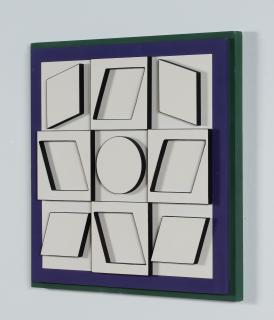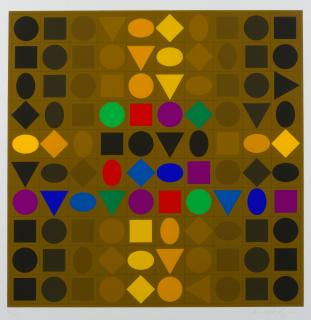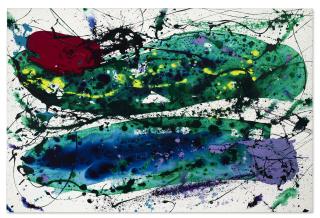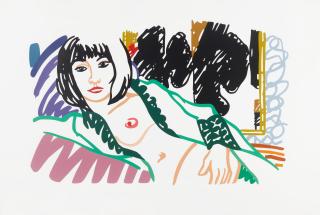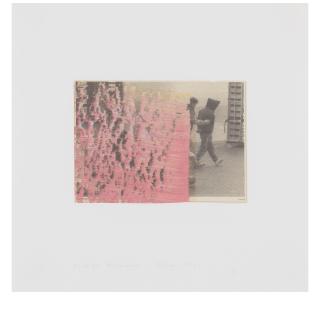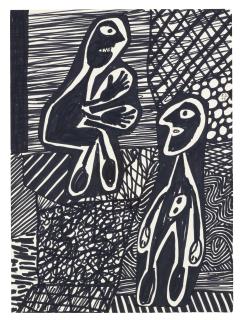Victor Vasarely 1906 - 1997
The artist Victor Vasarely
- Co-founder and major proponent of Op Art.
- Achieved international fame from the middle of the 20th century.
- His son, Yvaral, was also a prominent Op Artist.
Born in Hungary in 1906, the painter and graphic artist is retrospectively considered one of the founders and most important representatives of illusory Op Art. Vasarely first studied at the Podolini-Volkmann Academy in Budapest and then at the Mühely School of Graphic Arts. At the time, the school was run in the tradition of the Bauhaus by the Hungarian artist Sándor Bortnyik.
In 1930, Vasarely's path took him to Paris. During this time, he worked as a commercial artist, designing posters. For the first time, he turned to graphic patterns and illusions, the so-called trompe-l'œil (French for »deceiving the eye«). It took Vasarely 14 years to devote himself exclusively to painting, and he had his first exhibition at the Denise René in Paris. In addition to various patterns, figurative works were also shown. From 1947 onwards, Vasarely's focus was on geometric and abstract compositions.
In the 1950s, with the advent of kinetic art, on which the artist concentrated for several years, Vasarely's typical »reproducible« art emerged. He signed a manifesto for the group exhibition Le Mouvement at Denise René. It called for a work of art to be considered a prototype. Its forms could be easily duplicated in series and used outside of art.
After the 1955 exhibition, Vasarely's international recognition continued: he took part in the first four editions of the documenta (1955 – 1968) and won prizes such as the Guggenheim Prize in New York (1964) and the Grand Prize of the São Paulo Biennial (1965). Vasarely not only produced works of art, but also decorated building facades to emphasize his basic concept of systematizing art. The Op-Art pioneer died of cancer in 1997. He left behind a son who was also a well-known Op-Art artist under the pseudonym Yvaral (1934 – 2002).
Der Künstler Victor Vasarely
- Mitbegründer und bedeutender Vertreter der Op-Art.
- Erfuhr ab Mitte des 20. Jahrhunderts internationales Renommee.
- Sein Sohn agierte unter dem Namen Yvaral ebenfalls als bekannter Op-Art-Künstler.
Der 1906 in Ungarn geborene Maler und Grafiker zählt retrospektiv betrachtet zu den Begründern und wichtigsten Vertretern der illusorischen Op-Art. Vasarely studierte zunächst in Budapest an der Podolini-Volkmann Akademie, bevor er auf die Mühely-Schule für Grafik ging. Der ungarische Künstler Sándor Bortnyik führte diese damals in der Tradition des Bauhauses.
1930 führte Vasarelys Weg nach Paris. Er arbeitete in dieser Zeit als Werbegrafiker, entwarf Poster – und wandte sich das erste Mal grafischen Mustern und Illusionen, dem sogenannten Trompe-l’œil (frz. »täusche das Auge«). Es dauerte 14 Jahre, bis Vasarely sich ausschließlich der Malerei widmete und seine erste Ausstellung in der Denise René in Paris bekam. Neben verschiedenen Mustern wurden damals auch noch figurative Arbeiten gezeigt. Ab 1947 zielte Vasarely dann auf geometrische und abstrakte Kompositionen ab.
Zur vasarely-typischen, »reproduzierbaren« Kunst kam es in den 1950ern anlässlich der kinetischen Kunst, auf die sich der Künstler für einige Jahre konzentrierte. Er unterschrieb ein Manifest zur Gruppenausstellung Le Mouvement bei Denise René. Es verlangte, ein Kunstwerk als Prototyp zu betrachten, dessen Formen man leicht seriell vervielfältigen und auch außerhalb der Kunst verwenden können sollte.
Nach der Ausstellung 1955 erfuhr Vasarely stetig Anerkennung, auch auf internationaler Ebene: Er nahm an den ersten vier documenta Ausgaben teil (1955 – 1968), gewann Preise wie den Guggenheim-Preis in New York (1964) oder den Großen Preis der Biennale von São Paulo (1965). Vasarely fertigte nicht nur Kunstwerke, sondern verzierte auch Gebäudefassaden, was seine Grundauffassung der Systematisierung von Kunst unterstreichen sollte. Der Op-Art-Pionier starb 1997 an den Folgen einer Krebserkrankung und hinterließ mitunter einen Sohn, der unter dem Pseudonym Yvaral (1934 – 2002) ebenfalls als bekannter Op-Art-Künstler agierte.

